Assessing Maker Education Projects
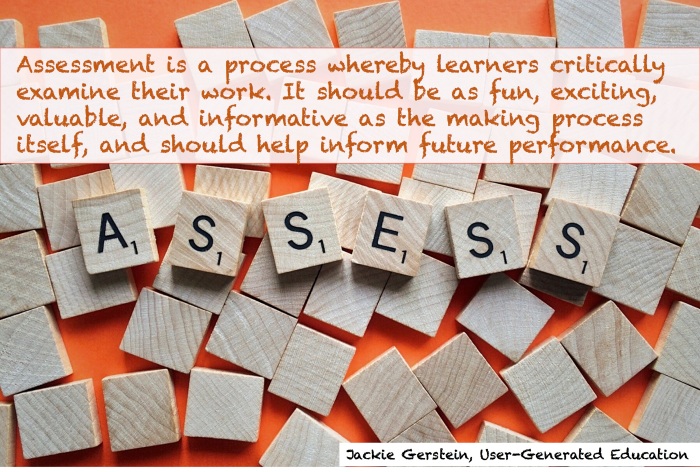
Institutionalized education has given assessment a bad reputation; often leaves a sour taste in the mouths of many teachers, students, and laypeople. This is primarily due to the testing movement, the push towards using student assessment in the form of tests as a measure of student, teacher, principal, and school accountability.
Educators should be clear about why they include assessment in their instruction; be strategic and intentional in its use. For me, assessment really should be about informing the learner about his or her performance so that increased learning and future improvement result for that learner.
Assessment is the process of gathering and discussing information from multiple and diverse sources in order to develop a deep understanding of what students know, understand, and can do with their knowledge as a result of their educational experiences; the process culminates when assessment results are used to improve subsequent learning. (Learner-Centered Assessment on College Campuses: Shifting the Focus from Teaching to Learning)
As Hattie, Fry, and Fischer note in Developing “Assessment Capable” Learners:
If we want students to take charge of their learning, we can’t keep relegating them to a passive role in the assessment process.
When we leave students out of assessment considerations, it is akin to fighting with one arm tied behind our backs. We fail to leverage the best asset we have: the learners themselves. What might happen if students were instead at the heart of the assessment process, using goals and results to fuel their own learning? ((http://www.ascd.org/publications/educational-leadership/feb18/vol75/num05/Developing-%C2%A3Assessment-Capable%C2%A3-Learners.aspx)
Maker Education and Assessment
As maker education infiltrates more formal educational settings, there’s been and will continue to be efforts to include assessment as part of its implementation. It is important, though, to keep in mind the characteristics of maker education and the role assessment has within it.
Making innately provides evidence of learning. The artifact that results, in addition to the process that a student works through, provides a wealth of evidence, indicators, and data of their learning. Overall, though, assessing making comes back to the original (and difficult) question of what learning outcomes we’re seeking. Assessment is critical for understanding the scope and impact of learning, as well as the associated teaching, environment, culture, and content. (https://www.edutopia.org/blog/assessment-in-making-stephanie-chang-chad-ratliff)
Being a teacher, you’re constantly faced with having to assess student learning,” said Simon Mangiaracina, a sixth-grade STEM teacher. “We’re so used to grading work and giving a written assessment or a test. When you’re involved in maker education it should be more dynamic than that.” Part of the difficulty is that, in evaluating a maker project, teachers don’t want to undo all of the thinking that went into it. For instance, one of the most important lessons maker education can teach is not to fear failure and to take mistakes and let them inform an iterative design process — a research-informed variation of “guess and check” where students learn a process through a loop of feedback and evaluation. (https://rossieronline.usc.edu/maker-education/7-assessment-types/ from USC Rossier’s online master’s in teaching program)
I have my gifted students do lots maker activities where I meet with the 2nd through 6th graders for 3 to 5 hours a week. Since I do not have to grade them (not in the traditional sense as I have to write quarterly progress reports), I don’t have to give them any tests (phew!). I do ask them, though, to assess their work. I believe as Dale Dougherty, founder of MAKE Magazine, does:
[Making] is intrinsic, whereas a lot of traditional, formal school is motivated by extrinsic measures, such as grades. Shifting that control from the teacher or the expert to the participant to the non-expert, the student, that’s the real big difference here. Dale Dougherty
Christa Flores in Alternative Assessments and Feedback in a MakerEd Classroom stated:
In a maker classroom, learning is inherently experiential and can be very student driven; assessment and feedback needs to look different than a paper test to accurately document and encourage learning. Regardless of how you feel about standardized testing, making seems to be immune to it for the time being (one reason some schools skip the assessment piece and still bill making as an enrichment program). Encouragingly, the lack of any obvious right answers about how to measure and gauge success and failure in a maker classroom, as well as the ambiguity about how making in education fits into the common standards or college readiness debate, has not stopped schools from marching forward in creating their own maker programs.
If the shift of control is given to the students within maker education settings, then it follows that the students should also be in charge of their assessments. One of the goals of maker education should be self-determined learning. This should include learners engaging in their own personal and personalized form of assessment.
Student self-assessment involves students in evaluating their own work and learning progress.
Self-assessment is a valuable learning tool as well as part of an assessment process. Through self-assessment, students can:
- identify their own skill gaps, where their knowledge is weak
- see where to focus their attention in learning
- set realistic goals
- revise their work
- track their own progress
- if online, decide when to move to the next level of the course
This process helps students stay involved and motivated and encourages self-reflection and responsibility for their learning. (https://teachingcommons.stanford.edu/resources/teaching/evaluating-students/assessing-student-learning/student-self-assessment)
Witnessing the wonders of making in education teaches us to foster an environment of growth and self-actualization by using forms of assessment that challenge our students to critique both their own work and the work of their peers. This is where the role of self-assessment begins to shine a light. Self-assessment can facilitate deeper learning as it requires students to play a more active role in the cause of their success and failures as well as practice a critical look at quality. (Role and Rigor of Self-Assessment in Maker Education by Christa Flores in http://fablearn.stanford.edu/fellows/sites/default/files/Blikstein_Martinez_Pang-Meaningful_Making_book.pdf)
Documenting Learning
To engage in the self-assessment process of their maker activities, I ask learners to document their learning.
We need to integrate documenting practices as part of making activities as well as designing, tinkering, digital fabrication, and programming in order to enable students to document their own learning process and experiment with the beauty of building shared knowledge. Documentation is a hard task even for adults, but it is not so hard if you design a reason and a consistent expectation that everyone will collect and organize the things they will share. (Documenting a Project Using a “Failures Box” by Susanna Tesconi in http://fablearn.stanford.edu/fellows/sites/default/files/Blikstein_Martinez_Pang-Meaningful_Making_book.pdf)
Documenting their learning can include one or a combination of the following methods:
- Taking notes
- Talking to a fellow learner or two.
- Making sketches
- Taking photos
- Doing audio recordings
- Making videos
(For more information, see Documenting Learning https://usergeneratededucation.wordpress.com/2016/04/08/documenting-learning/)
The folks at Digital Promise have the following message for maker educators regarding documentation:
Make the documentation an organic and expected part of the process. When documentation feels like it is added without reason, students struggle to engage with the documentation process. Help students consider how in-process documentation and reflection can help them adapt and improve the project they are working on. Help them see the value of taking time to stop and think.(http://global.digitalpromise.org/teachers-guide/documenting-maker-projects/)
Documenting learning during the making process serves several purposes related to assessment:
- It acts as ongoing and formative assessment.
- It gives learners the message that the process of learning is as important as the products of learning, so that their processes as well as their products are assessed. (For more information on the process of learning, see Focusing on the Process: Letting Go of Product Expectations https://usergeneratededucation.wordpress.com/2017/12/17/focusing-on-the-process-letting-go-of-product-expectations/)
Maker Project Reflections
Because many students haven’t had the experience of reflection and self-assessment, I ease them into this process. With my gifted students, I ask them to blog their reflections after almost all of their maker education activities. They take pictures of their makes, and I ask them to discuss what they thought they did especially well, and what they would do differently in a similar future make. Here are some examples:
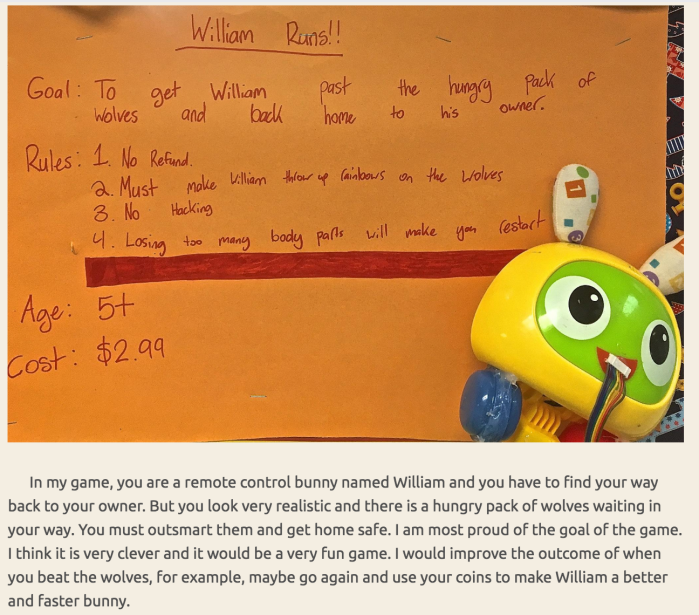
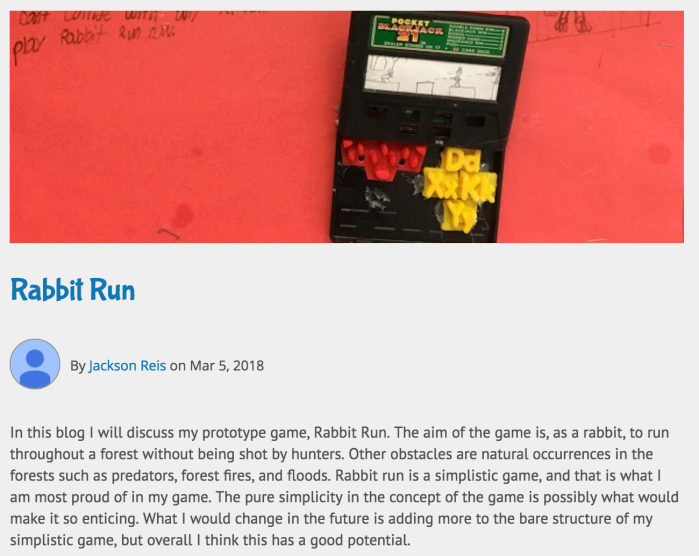
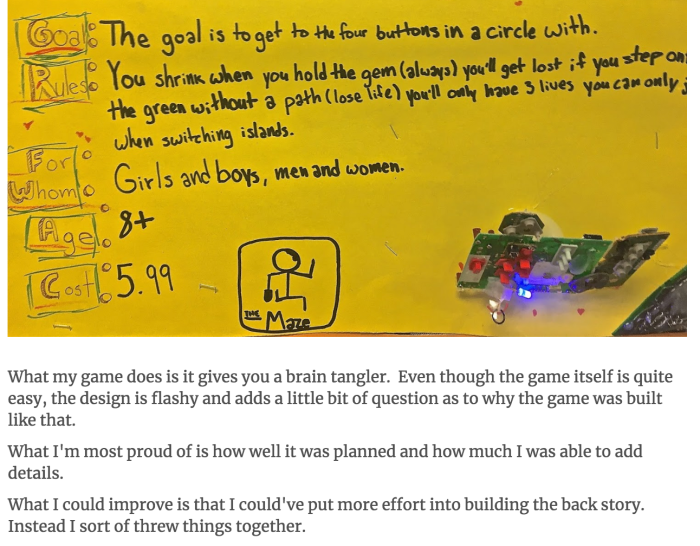
Teacher and Peer Feedback
The learners’ peers and their educators can view their products, documented learning, and reflections in order to provide additional feedback. A culture of learning is established within the maker education community in that teacher and peer feedback is offered and accepted on an ongoing basis. With this type of openness and transparency of the learning process, this feedback not only benefits that individual student but also the other students as they learn from that student what worked and didn’t work which in turn can help them with their own makes.
The Use of Assessment Rubrics
As a final thought, there has been some thoughts and efforts into using rubrics as assessment tools. Here is one developed by Lisa Yokana and discussed in Creating an Authentic Maker Education Rubric
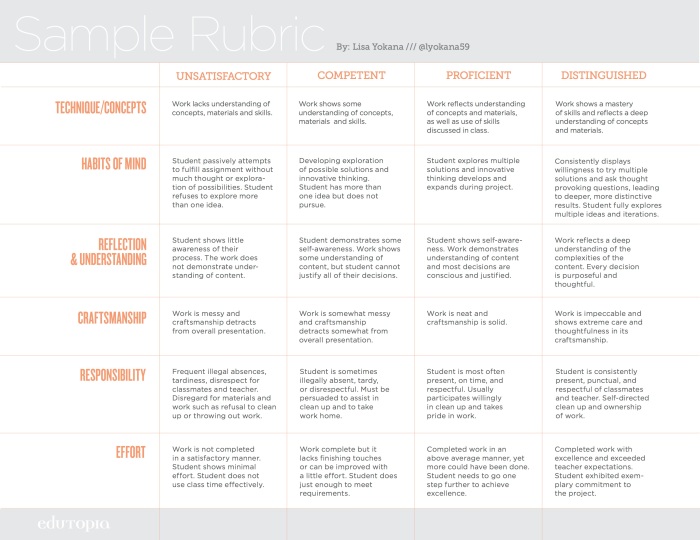
I think rubrics, such as this, can be of value in assessing student work and/or having them assess their own work, but I prefer more open ended forms of assessment so the learners can but more of their selves into the process.

Leave a comment